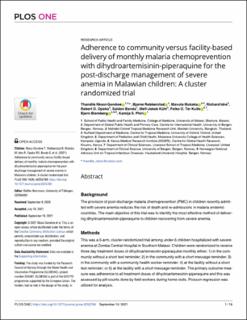| dc.description.abstract | Background: The provision of post-discharge malaria chemoprevention (PMC) in children recently admitted with severe anemia reduces the risk of death and re-admissions in malaria endemic countries. The main objective of this trial was to identify the most effective method of delivering dihydroartemesinin-piperaquine to children recovering from severe anemia.
Methods: This was a 5-arm, cluster-randomized trial among under-5 children hospitalized with severe anemia at Zomba Central Hospital in Southern Malawi. Children were randomized to receive three day treatment doses of dihydroartemesinin-piperaquine monthly either; 1) in the community without a short text reminder; 2) in the community with a short message reminder; 3) in the community with a community health worker reminder; 4) at the facility without a short text reminder; or 5) at the facility with a short message reminder. The primary outcome measure was adherence to all treatment doses of dihydroartemesinin-piperaquine and this was assessed by pill-counts done by field workers during home visits. Poisson regression was utilized for analysis.
Results: Between March 2016 and October 2018, 1460 clusters were randomized. A total of 667 children were screened and 375 from 329 clusters were eligible and enrolled from the hospital. Adherence was higher in all three community-based compared to the two facility-based delivery (156/221 [70·6%] vs. 78/150 [52·0%], IRR = 1·24,95%CI 1·06–1·44, p = 0·006). This was observed in both the SMS group (IRR = 1·41,1·21–1·64, p<0·001) and in the non-SMS group (IRR = 1·37,1·18–1·61, p<0·001). Although adherence was higher among SMS recipients (98/148 66·2%] vs. non-SMS 82/144 (56·9%), there was no statistical evidence that SMS reminders resulted in greater adherence ([IRR = 1·03,0·88–1·21, p = 0·68). When compared to the facility-based non-SMS arm (control arm), community-based delivery utilizing CHWs resulted in higher adherence [39/76 (51·3%) vs. 54/79 (68·4%), IRR = 1·32, 1·14–1·54, p<0·001].
Interpretation: Community-based delivery of dihydroartemesinin-piperaquine for post-discharge malaria chemoprevention in children recovering from severe anemia resulted in higher adherence compared to facility-based methods. | en_US |

